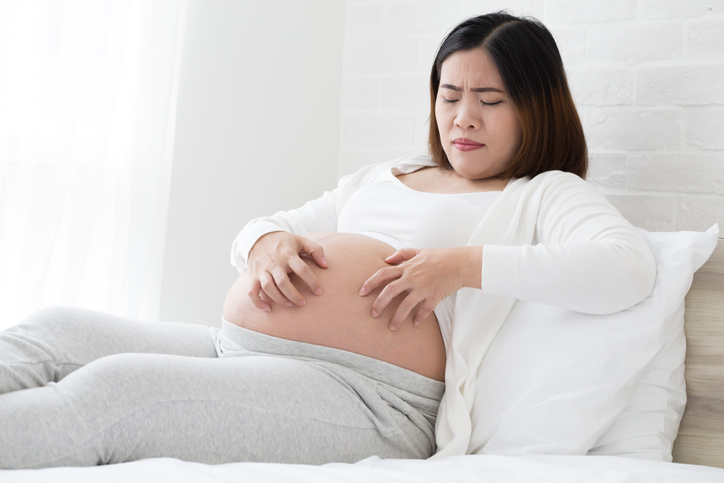Your body goes through some major physical and emotional changes during pregnancy, which is unsurprising given the nature of pregnancy itself.
But some pregnancy symptoms might be a little more surprising than others.
The round ligament of the uterus undergoes a lot of stress during pregnancy and feeling abdominal pain is entirely common.
But what exactly causes it, what does it feel like, and how can it be remedied? Here’s everything you need to know.
What Is a Round Ligament?
The round ligaments are a group of rope-like connective tissue that support the uterus, or womb, where a child forms.
There are two round ligaments of the uterus, one on both sides, and each is about four inches in length.
Another round ligament in the liver forms the umbilical cord — a blood vessel that carries blood from the placenta to the fetus. However, when most people refer to the round ligament, they refer to the ones around the uterus.
What Does Round Ligament Pain Feel Like?
Round ligament pain is often thought of as “growing pains” during pregnancy.
The symptoms of round ligament pain include an uncomfortable sensation felt near the hips, lower abdomen, and groin. Individuals with round ligament pain often describe dull aches, cramps, or a sharp pulling sensation.
This pain typically occurs during the second trimester of pregnancy, which falls during weeks 14 through 27. With that said, it can appear earlier or later.
The sensation can occur on just one or both sides of the body and usually only lasts for a few seconds at a time. It often happens repeatedly during the second trimester.
Round ligament pain can also worsen if you make sudden movements, like sitting down quickly, laughing, coughing, or sneezing.
Why Does Round Ligament Pain Happen?
During pregnancy, an individual’s body makes hormones called relaxin. Relaxin makes the ligaments looser and stretchier, which allows the body to adjust to growing a baby and prepare for birth.
Your uterus and round ligaments stretch as a baby grows in the womb, which can cause muscle spasms and feelings of discomfort and pain.
However, in rare cases, it could be a sign of endometriosis when the uterine lining grows outside the uterus.
Additionally, it can result from round ligament varicosity, when varicose veins develop in the round ligament and cause pain or swelling.
Remedies for Round Ligament Pain
Round ligament pain is a bit of a necessary evil during pregnancy. And while it is typically just a mild sensation, there are things you can do for pain relief.
Stretching Exercises
There are plenty of stretches and exercises that you can do to alleviate the feeling of round ligament pain. Most of this remedy revolves around strengthening the core and tightening the abdomen.
Try these options if your doctor gives you the green light to exercise.
Try laying down on the floor or in bed on your back.
Take a deep breath and brace your abdomen as if someone is about to punch you in the tummy. While holding your breath, push the small of your back into the floor and hold this position for five counts while you exhale.
You can also try taking some prenatal yoga classes to help strengthen your core while reducing stress and anxiety.
Yoga can also help you stretch out other joints and ligaments that might feel uncomfortable throughout pregnancy.
Flexing the Hips When Coughing, Sneezing, or Laughing
Sudden, quick movements that contract the pelvic floor can cause discomfort to the round ligaments and make pain feel worse.
For that reason, you can reduce some of the discomfort by flexing your hips and abs slightly before the sudden movement takes place.
Changing Positions
Pregnancy sleeping is challenging, and some people experience round ligament pain when lying down. If you notice more pain at night, change positions (but avoid your back and stomach).
Whether sleeping on your left or right side, try placing a pillow between your legs to help alleviate pressure on your back.
A Warm Bath
There isn’t anything better than a nice relaxing, warm bath. And outside of the mental benefits that a bath can bring to the stressors of a pregnant body, heat treatments can offer plenty of physical benefits for round ligament pain.
Heat can open up the blood vessels and aid in the healing process of injuries alleviating some pain. A warm bath can effectively reduce your pain, at least for a short while during the bath itself.
Ensure the temperature is below 100 degrees Fahrenheit, as temperature regulation is crucial. You may also want to consider using a heating pad to alleviate some discomfort.
Searching pregnancy products? We have some recommendations! 🤰🤰
👶👶 TOP RECOMMENDATION: The Genate Prenatal Nutritional Test: Optimize the prenatal nutrition you share with your developing baby or newborn: LEARN MORE.
——- Additional Recommendations ——
📚 Mayo Clinic Guide to a Healthy Pregnancy, 2nd Edition: LEARN MORE.
📚 The Pregnancy Encyclopedia: All Your Questions Answered: LEARN MORE.
🧘 WorkoutLabs Prenatal Yoga & Ayurveda Cards: LEARN MORE.
*If you buy something from a link on our site, we may earn a commission. See our advertising disclosure.
Pain Medications
Pain medications won’t fix underlying pain, but they can help alleviate discomfort temporarily.
It’s considered safe for pregnant individuals to take certain pain medications such as acetaminophen ( Tylenol) during pregnancy to help reduce pain related to round ligament stiffness.
With that said, you should always talk to your OB-GYN or healthcare provider before you start taking any type of medication while pregnant.
Round Ligament Pain vs. Contractions
The sensation of round ligament pain can feel similar to the feelings associated with contractions.
However, the main difference is that contractions can occur anytime, whereas round ligament pain is almost always triggered by movement.
Additionally, round ligament pain is a sharp, shooting pain that lasts for just a few seconds, whereas contractions last much longer.
Contractions can also increase in strength, but round ligament pain usually doesn’t worsen over time.
If you’re in labor, contractions can last anywhere from 30 to 70 seconds and are about five to 10 minutes apart. At that point, they’re so strong that you can’t walk or talk during them.
If you feel intense or stabbing pain of this level, it’s time to make your way to the hospital because the baby just might be arriving!
When Should I Be Worried About Round Ligament Pain?
Round ligament pain is a normal part of pregnancy; in most cases, it’s nothing to be concerned about.
However, you may want to contact your obstetrics and gynecology provider if you feel any of the following symptoms, as they might be a sign that something is wrong outside of just your round ligaments expanding:
- Sudden lower back pain
- Fever
- Vaginal bleeding, accompanied by a sharp pain
- Severe pain, often accompanied by pelvic pressure
In Conclusion
The round ligaments of the uterus are a group of connective tissue that support the uterus.
When pregnant, the body produces more of a hormone called relaxin, which loosens the ligaments. The round ligaments expand and can start to feel tense and painful as they make room for a baby.
Round ligament pain typically doesn’t feel too painful; it’s more like brief pulling or tension. Round ligament pain is often caused by sudden movements, like sneezing or laughing.
You can try to remedy it by stretching, taking a hot bath, or flexing your hips when coughing or laughing. If you start to feel intense pain or experience vaginal bleeding, it might be time to visit a healthcare professional.
References, Studies and Sources:
Round Ligament Of The Uterus: Anatomy & Function | Cleveland Clinic
Relaxin in Human Pregnancy | NCBI
Endometriosis – Symptoms and causes | Mayo Clinic
Contractions and signs of labor | March of Dimes

Bridget Reed is a Tampa-based content development manager, writer, and editor at GR0; specializing in content related to varying fields including medicine, health, and small businesses. Bridget went to St. Petersburg College and majored in Management and Organizational Leadership.
Recent Publications: Body Acne 101: Prevention and Treatment, Stress Acne: Causes, Prevention, and Treatment, What are the Side Effects of Midol?

